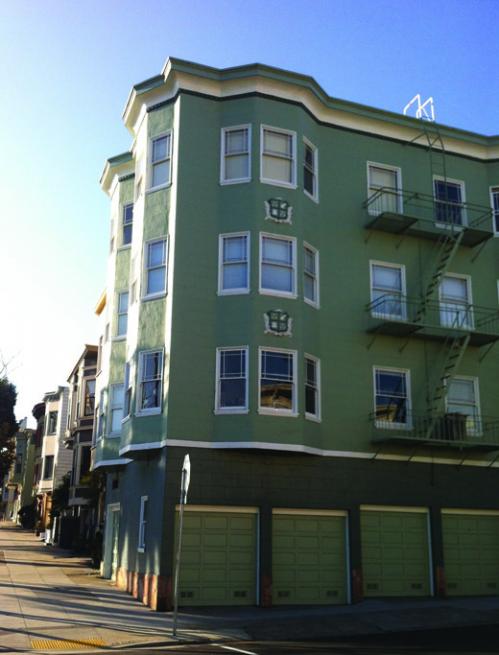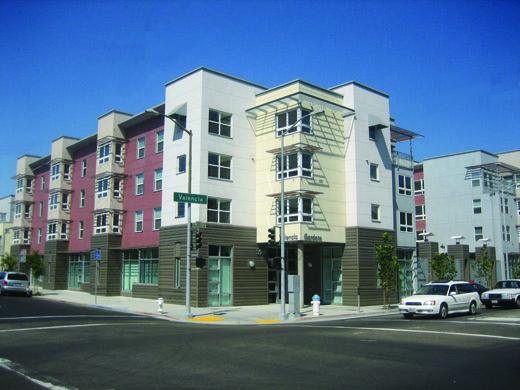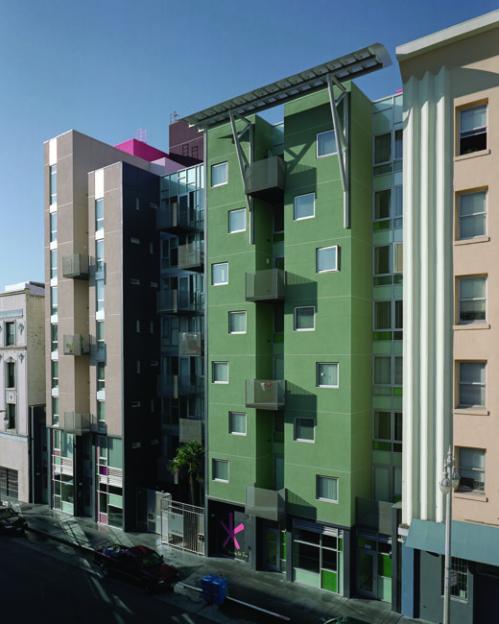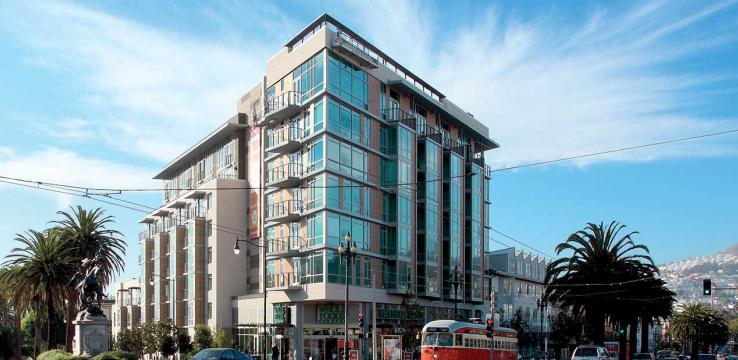This article is excerpted from the SPUR policy proposal 8 Ways to Make San Francisco More Affordable.
Read the complete proposal >>
San Francisco is in the midst of an affordability crisis. We are all feeling the impact as the rising cost of housing threatens to drive away the diversity that makes this city so special.
Locally, the problem stems from the high levels of job creation in the region, the fact that a new generation of workers clearly prefers city living to the suburbs, and the thicket of regulatory constraints that San Francisco has enacted, which make it difficult to add new housing supply. In short, there is much higher demand for housing than supply can meet.
San Francisco added jobs at a faster rate in 2013 than any other U.S. city. The city budget has grown by $700 million in the last year, exceeding that of many states. The economic miracle of the Bay Area is something we can be proud of. But San Francisco is about a lot more than making money. San Francisco’s progressivism, its openness and its cosmopolitan celebration of diversity are what make so many of us care fiercely about this place and its future. It’s the sense that we stand for something. This is a place where social movements, and advances in artistic freedom and self-expression, emerge and are nurtured before they go on to change the world.
The reality, however, is that San Francisco has long been more closed than it would like to be, largely as a result of high housing costs. And our current boom times have pushed this long-standing strain to a breaking point. This issue of The Urbanist focuses on what can be done to make San Francisco more affordable. It presents SPUR’s best ideas for tackling this problem together as a city through far-reaching changes to our housing policies. The solutions sketched here have two great virtues: They are legal, and they are possible to implement at the local level. Our job is to care about the entire continuum of housing, from affordable to marketrate, and the ideas presented here would bring significant benefits to all levels.
Not all of the solutions can be found within housing policy. We should also be thinking about things like a higher city minimum wage (to increase purchasing power at the bottom of the income scale) and a major reinvestment in Muni (to reduce household transportation costs). But in this issue, we are focused on housing.
To make progress in 2014, we are looking forward to working with the mayor, the Board of Supervisors, the city departments and the cross section of people who care about this issue. Many people are afraid right now, worried about what will happen to them if they lose their housing. But there are things we can do at the local level that would make a big difference.
This housing agenda is the start of a conversation about how we can respond constructively to this crisis. Nothing could be more in keeping with San Francisco’s character than to emerge with progressive solutions to affordability and displacement, solutions that will actually work, in a way that we can be proud of here and that may even be a model for the rest of the world.
1. Protect the existing rent controlled housing stock.
San Francisco has roughly 172,000 units of rentcontrolled housing. Rent control is the city’s core tenant protection, allowing many people to stay here. The first thing the city needs to do is to make sure we don’t lose those units.
As housing prices go up, there is ever more incentive for owners of rental units to find a way to get out of the landlord business and sell the units. One of the most often abused mechanisms is California’s Ellis Act, a state law that gives landlords the unconditional right to evict tenants to “go out of business.”

Allison Arieff
Tenant groups in San Francisco developed a set of proposals to make it more difficult for landlords to use the Ellis Act as a tool to evict people. One of the proposed reforms that makes sense is to discourage the practice of buying rent-controlled units for the purpose of converting to tenancy-in-common units (TICs) or condos by requiring landlords to actually have been in the landlord business for a period of time before using the Ellis Act to “leave the business.”
There is a social compact in San Francisco that needs to be upheld: Rent-controlled units should stay under rent control while ownership opportunities should come from new construction.
2. Reinvest in San Francisco’s public housing stock.
The San Francisco Housing Authority has 6,300 units of public housing (like Valencia Gardens, shown above) and roughly 9,000 Section 8 vouchers (which help subsidize rents for low-income tenants). The city is in the process of figuring out a broad public housing reform plan to better manage this housing stock and provide resources to upgrade many of the public housing buildings.
At the same time, the city is also working on an ambitious plan to rehabilitate its most troubled public housing units as part of a program called HOPE SF. With HOPE SF, the city is seeking to build in a comprehensive set of social services to give residents the resources to get out of poverty. San Francisco has started this process by identifying the highest-need public housing developments (such as those at Sunnydale and Potrero Terrace) and pairing them with project sponsor teams, but much of the funding for both the redevelopment and the resident services still needs to be identified.

Courtesy VMWP
HOPE SF and the broader set of public housing renovations offer an opportunity to physically knit public housing back into the fabric of the city. But most important, it means we will keep all those affordable units habitable.
3. Double the amount of subsidized affordable housing.
San Francisco has about 16,000 units of “affordable” rental housing (not including public housing), most owned by nonprofits. We need to build more.
Building housing is expensive (see p. 11). It costs as much to construct affordable housing units as market-rate units. But because affordable housing is subsidized, the prices paid by residents are reduced. The average subsidy per unit in San Francisco is around $250,000.
The roughly 16,000 units the city has today (including Curran House, shown at left) were built over a period of four decades. This is a long-term social housing program of which San Francisco should be proud. But given San Francisco’s wealth and our enormous problem of housing affordability, we suggest the city adopt a long-term goal of doubling the current supply of subsidized affordable housing.
In 2012, San Francisco voters passed the Affordable Housing Trust Fund, which will ultimately set aside around $50 million from the city budget each year for affordable housing construction. If we can get the State of California to create a new affordable housing program, or create one regionally ourselves, we can make our local funding go further.

Courtesy David Baker Architects
But given the uncertainty of committed state and regional funding sources, it’s time for the city to make a couple of targeted investments with local money. We are experiencing extraordinary growth in the city budget right now as a result of the boom. San Francisco’s revenues for fiscal year 2013–14 are projected to be $700 million larger than the previous year. The city should consider some one-time allocations from its budget for the next couple of years to directly impact affordability. This money could be spent on helping to rebuild the public housing mentioned above, or it could be spent helping to buy existing buildings and making the units affordable to low-income tenants.
Doubling the amount of permanently affordable housing is an expensive prospect, but we have a base to work from: thousands of affordable projects in the development pipeline, significant funding already in place and lots of affordable housing developers who know how to produce and manage these units.
4. Add supply at all levels.
We got into this housing crisis because San Francisco doesn’t have enough places to live to meet demand.
Demand to live here is high because this is a wonderful place and because our regional economy is generating lots of good jobs. These are both good things. Supply is low because over the years the city has put rules in place that make it extremely difficult to build new housing. In an effort to preserve the physical city, we have inadvertently sacrificed the diversity that can only come with affordability.
If we want the city to remain a place in which all types of people can afford to live, we must remove obstacles to adding housing. We’ve seen the social consequences of not doing that. Our best guess is that if we added 5,000 units a year for a sustained period of time, prices would stabilize. While San Francisco has produced just 1,500 units a year over the past two decades, Seattle has averaged 3,000, adding the units in a way that has improved the vitality of its downtown and kept prices from rising as drastically. The lesson is clear: Making it easier to add housing supply keeps rents lower than making it hard to add supply does.
We can achieve more supply and more affordability through two types of reforms. First, we need to create more “zoned capacity” in the city — that is, more areas where city law allows housing to be added. The city usually does this by conducting neighborhood planning processes, in order to be precise about where to allow development and where not to. In fact, San Francisco has a great model for how to do the kind of planning that is community-driven and strengthens neighborhoods. (The Market and Octavia Plan, of which 38 Dolores (shown below) is a part of, and the Rincon Hill Plan are two good examples.) We just need to do more of it.
Second, we need to make it easier to actually build buildings that conform to the zoning rules we’ve decided on. In many American cities, permits are issued by city staffers, who merely check to make sure that a building conforms to the community’s zoning rules. But in San Francisco, even after we’ve done the work together of figuring out our zoning rules, buildings that fit them are routinely rejected, shrunk or delayed by years of process. We need to make our own plans count, by making it much, much easier to get permission to build according to zoning.
San Francisco has room to add places to live without changing the virtues of the city that we love. We can do this by building in appropriate areas, like downtown and along the core transit lines; filling in housing and street shopping on vacant lots; adding housing above the stores on neighborhood shopping streets; and opening up the opportunity for making secondary units (also known as “in-law units”) within existing homes in residential neighborhoods. These kinds of infill development bring the benefits of complete neighborhoods — walkability, great street life, safety and strengthened neighborhood identity. And with these kinds of investments in just a few areas, we could easily meet our housing needs while making the whole city more livable.
The preceding proposals could work at scale, but they leave unaddressed the thing everyone seems to be wishing for: a change to housing policy that will somehow lead to the production of middle-income housing — housing that is more affordable than what the market produces today but that doesn’t require subsidies.
It’s a tall order, but there are some strategies worth trying. It’s time to experiment.
One strategy falls into the category of reducing the actual hard construction cost of new housing. This generally means building units that are affordable by design, with less space or with fewer amenities than standard housing. This could mean creating smaller units like those proposed for 1532 Harrison (at right), encouraging secondary units throughout the city and building units without parking. All of these ideas are viable; many are in great demand. We should encourage creativity and flexibility in the quest for middle-income options. Maybe we could pick a neighborhood where all new housing is encouraged to be car-free. (In many neighborhoods, a majority of households are already choosing to live this way.) And certainly the prohibition on secondary units in most of the city should be repealed.
Another strategy is to form strategic partnerships with universities to get them to build more housing for their students and faculty. These units could be on or off campus; the point would be to ease some number of students and faculty out of the competition for the rest of the housing supply.
A third strategy is to create a new option for the city’s inclusionary housing law, which requires below-market-rate units to be paid for by market-rate developments. Perhaps there is a way to experiment with a shallower subsidy for a larger number of units — in essence, spreading the same development subsidy across more people to see if we can increase the supply of middle-income housing this way.
Finally, there may be a way for the city government to use publicly owned land in new ways. Can the city put surplus land into development for housing but somehow impose a new kind of price control that ensures it is used for middle-income units? Perhaps there is an adaptation of the land trust model that the city could use for this purpose.
The middle-income housing idea is not easy to pull off. It’s best to pursue any program that tries to target income in this way with a spirit of experimentation. It’s worth seeing what might be achieved.
5. Launch a wave of experiments to produce middle-income housing.
1532 Harrison Street Group Housing proposed by Build, Inc. and Macy Architecture, rethinks conventional multi-family floorplans with this plan for 235 double occupancy, group housing “suites,” which would be grouped into 28 individual group “houses.” Each house would contain 10 suites, each including bedroom, bath and kitchenette. Every suite would be clustered around a coliving space with kitchen, dining, living room, laundry and a balcony.

Courtesy Build Inc. / Macy Architecture
6. Use new property taxes from growing neighborhoods to improve those neighborhoods.
At first, this strategy might not sound like it has anything to do with housing affordability, but it does, because it supports conditions in which wellconsidered development can continue to happen.
Right now, certain neighborhoods are growing a lot more than others. If those neighborhoods are going to continue to grow, their current residents need to experience tangible benefits beyond the good feeling that they are doing their part to meet regional housing demand. We need to establish a bargain in which neighborhoods that accept growth can experience an improved neighborhood as part of the deal.

Courtesy San Francisco Parks Alliance
Of course there are people who will oppose physical change no matter what — even if, like Emerald Park (at left), it’s well designed, even if it’s in the right locations, even if it comes with neighborhood improvements. Every city has people like that. But we have to recognize that there are also legitimate concerns from people who care about their neighborhoods. The promise of new development is not just that the new buildings themselves will improve neighborhoods (although if well designed, they often do), not just that the buildings will provide more customers to support more retail options (although this usually happens), but also that the new construction will provide funding to undertake public improvements in the neighborhood: parks, sidewalk widening, transit improvements, etc. This was implicitly promised in many of the neighborhood plans that were adopted. The city needs to do more to make good on those promises.
Some of the neighborhoods south of downtown that were planned for high-rise development (South Beach, Rincon Hill and Transbay) are generating hundreds of millions of dollars every year in new property taxes, way above the costs of providing basic public services to those neighborhoods. More of this money should be spent making improvements to the neighborhoods that are generating the revenue.

Conclusion: Hard Truths
In the long run, the only solution that will actually benefit the vast majority of people who need help is to fix the supply problem. Most of the measures we can enact will take years, if not decades, to show results.
It’s also important to remember that it’s not just San Francisco that needs to build more housing. Every city in the region needs to do its part if we are going to impact housing prices. If other cities of the Bay Area worked to create more walkable neighborhoods, there would be less gentrification pressure on the few that we do have. As everyone points out, we can’t look at this issue just within one city. Oakland, San Jose and the other cities of the Bay Area are all part of the solution.
Our work in San Francisco would be much easier if we had support from the national level, both to provide help for a social housing program and, more fundamentally, to address income inequality. But as that doesn’t appear to be forthcoming we must take the lead locally. We may be one of the first cities to experience this problem in which huge new demand for city living requires us to change our approach to affordability, but we certainly won’t be the last.
This article is excerpted from the SPUR policy proposal 8 Ways to Make San Francisco More Affordable.
Read the complete proposal >>
--
[1] SF Planning Department estimate based on 5 Year American Communities Survey, 2010.
[2] Number of units paying rent board fee (not included: owner-occupied, illegal, vacant).
[3] SPUR memo on Housing Authority/HUD recognized units.
[4] San Francisco Human Services Agency.
[5] Mayor’s Office of Housing and Community Development.
[6] SF Planning Department estimate based on 5-Year American Communities Survey 2010.
[7] 5-Year American Communities Survey, 2010.

